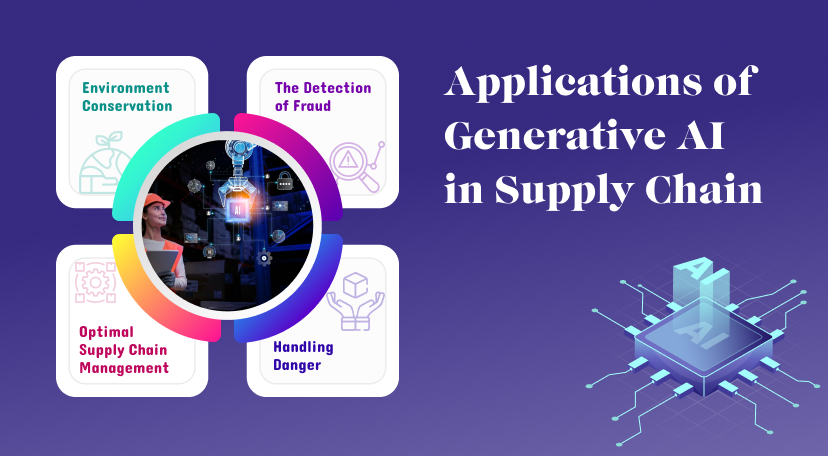Applications of Generative AI in Supply Chain

Supply chain management is one area where generative AI has several potential applications as follows:
- Environment Conservation: Companies may reduce their fuel costs and carbon footprint by optimizing their transport routes. The optimization of packing materials, promotion of ecologically friendly activities, and reduction of waste all contribute to a beneficial environmental effect.
- The Detection of Fraud: Businesses may benefit greatly from using AI to analyze financial data and spot patterns at a pivotal point in the supply chain. The chance of fraud may be predicted using the AI models, which can be trained using historical data.
- Optimal Supply Chain Management: Artificial intelligence (AI) models may be used to improve several facets of a company’s supply chain, including manufacturing schedules, delivery routes, and stock levels.
- Handling Danger: Generative AI in Supply chain can identify risks and mitigate them. Models may detect possible hazards and allow proactive risk mitigation techniques to improve the supply chain by examining external factors and historical data such as weather conditions, political instability, or supplier interruptions.
Tech Stack and Development of Generative AI in Supply Chain
Businesses can gain a lot from the research and development of generative AI in the supply chain, particularly in areas like production optimization and decision-making. The stages of creation are as follows:
Establish Goals and Use-Cases
Root planning, inventory optimization, demand forecasting, anomaly detection, and other applications of AI in supply chain management are just a few examples. When you have a firm grasp of the AI needs of your supply chain organization, you’ll be better equipped to identify goals and use cases.
Obtaining and Raw Data
Gather information about your inventory, sales history, suppliers, transportation, and even the weather to better manage your supply chain. Additionally, by incorporating AI into your supply chain, you may eliminate data inconsistency.
Tech Stack and Model Selection
You need to select the frameworks you would like to use depending on the expertise of your tech developers. Here is the tech stack to guide you.
- Generative Model Libraries: Keras, Hugging Face Transformers, Fastai
- Machine Learning Frameworks: TensorFlow, scikit-learn, PyTorch
- Data Preprocessing and Augmentation: Pandas, OpenCV, NumPy
- Model Visualization and Interpretability: SHAP, Matplotlib and Seaborn
- Hyperparameter Tuning and Optimization: TensorBoard, Optuna
- Cloud Services: Azure Machine Learning, AWS SageMaker, Google AI Platform
Thereafter you need to train your model using training data. The generative model will be taught by observing and analyzing existing data correlations and patterns. Additionally, divide your data into training, testing, sets, and validations and utilize a variety of optimization approaches to fine-tune your model’s parameters.
Supply Chain System Integration
Enterprise Resource Planning (ERP) systems, Warehouse Management Systems (WMS), and Transportation Management Systems (TMS) may all benefit from APIs or interaction points designed to integrate generative AI in supply chain.
Maintain and Enhance Constantly
If you want your AI model to be able to respond to shifting supply chain dynamics and perform better in general, you must constantly train and evaluate it with fresh data. An appropriate monitoring and alerting system may be implemented to monitor the AI model. Gather feedback from customers on how the AI solution is improving your supply chain, and utilize that information to make adjustments.
Development Challenges of AI in Supply Chain
Some difficulties and factors are involved in integrating generative AI in supply chain.
- Training generative AI models during app development for supply chains may be computationally demanding and time-consuming. Significant computational resources and expertise are needed to efficiently optimize and train complicated models for use in application development.
- Transparency and comprehension are needed so that the results may be clearly understood. For this reason, it’s not enough to just be able to explain anything; interpretability and explainability are also essential for winning over stakeholders’ approval and confidence.
- The dynamic nature of the supply chain makes it difficult for the generative AI model to learn from experience and quickly adjust to new information and circumstances. Therefore, to successfully integrate generative AI into the supply chain, it is necessary to combine real-time data sources and construct models capable of actual changes.
- Several variables, including system interruptions, compatibility problems, and the need for extra computer resources, might delay the deployment of complicated problems.
You can improve scalability and interoperability with current infrastructure and technologies, as well as assure a smooth supply chain integration, with some forethought and preparation.
Conclusion
The use of generative AI in supply chain is expected to grow in importance as the field develops. Investment in the development, and protection of sensitive information, and strategic AI implementation are all necessary for enterprises to fully realize AI’s potential. By automating routine tasks, providing data-driven insights, and enabling real-time decision-making, it enables organizations to respond swiftly to changing market conditions and customer demands.
FAQs
What is generative AI in the supply chain?
How does generative AI benefit the supply chain?
What are the challenges of implementing generative AI in the supply chain?
What are some real-world applications of generative AI in the supply chain?
How can organizations prepare for the adoption of generative AI in their supply chain?
Ravi Bhojani is the Chief Marketing Officer (CMO) at Alian Software, where he spearheads the company’s marketing strategies and drives its brand presence in the competitive IT services landscape. With over a decade of experience in the technology and marketing sectors, Ravi has consistently demonstrated his ability to blend innovative marketing techniques with deep industry knowledge to deliver outstanding results.